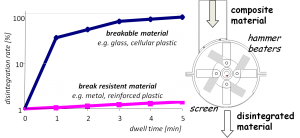My Projects
Topic: Disintegration
Title: Selective Comminution of Composite Waste
The diagram visualizes the well-known observation that some materials break easier than others.
In this case, the breaking forces are provided by a hammer mill with a flexible striking mechanism.
The broken material leaves the processing chamber by way of an integrated screen below.
After some minutes the breakable material is completely disintegrated and screened out.
What one doesn’t see:
The load of the impact by the flexible hammers can be varied by means of the rotation speed and the design of the striking beaters. The break resistant material is separated after a specific dwell time by an automatic discharge mechanism. Afterward, a new charge can be introduced.
What’s behind it:
By test series the parameters for rotation speed, beater design and dwell time are optimized to break one component quite quickly, whereas the other remains almost unbroken. Thereby the whole composite is disintegrated and sorted out in just one step. However, only in cases of quite different breaking properties, this principle of selective comminution is applicable. A controlled selectivity is hardly feasible since the impact conditions may differ a lot. If the material becomes plasticized due to the deformation and the dissipated energy, a suitable pre-cooling has to be installed. For the same reason, a cryogenic selection is generally not applicable for this process.
What you can obtain from it:
The dashboards of luxury class cars are formed by a sandwich composite: A core of cellular plastic provides a soft touch feeling, which on one side is covered with a shagreened backing film and on the other side with a high-strength carrier support. The removal of the core in-between results in a complete liberation of the whole material since the cellular plastic is always located between the backing and the carrier material. In production, the composite is strongly bonded in order to sustain equally strong and long-lasting stress by temperature, vibration, humidity and solar irradiation. Therefore, the dashboard is produced as a complete sheet and just afterward the inserts are stamped out for the steering wheel, the glove compartment, and other control instruments. In consequence, a large amount of virgin material arises already as production waste, which can directly be recovered and reused after a selective comminution.
My related publications:
Material Recovery of Composite Products, Proceedings Book Recycle’94, Davos/Schweiz, 10,1.1 -7 (1994)
Waste Processing by Comminution, Proceedings Recycle’95, Davos, Switzerland, 12-3.1/8 (1995)
Liberation of Composite Waste from Manufactured Products, Proceedings 8th European Conference on Comminution Stockholm, Sweden, 152-163 (1994) and International Journal of Mineral Processing 44/45, 143-153 (1996)
